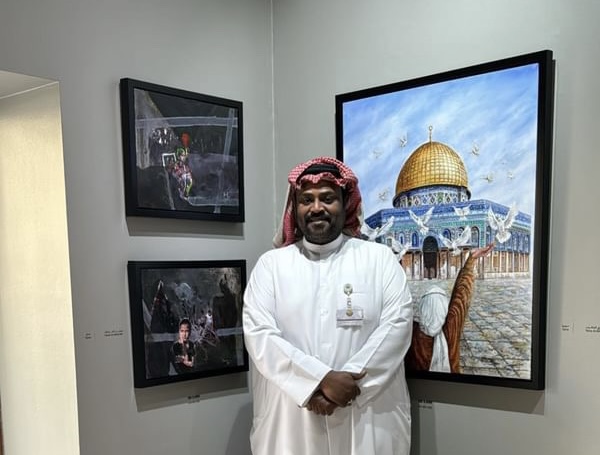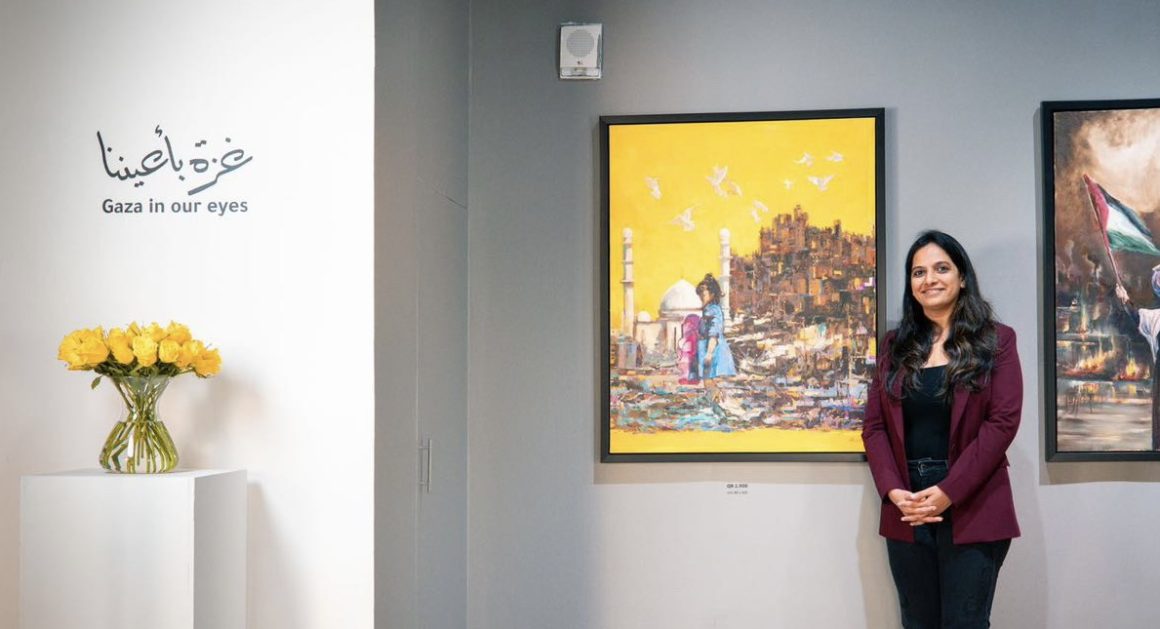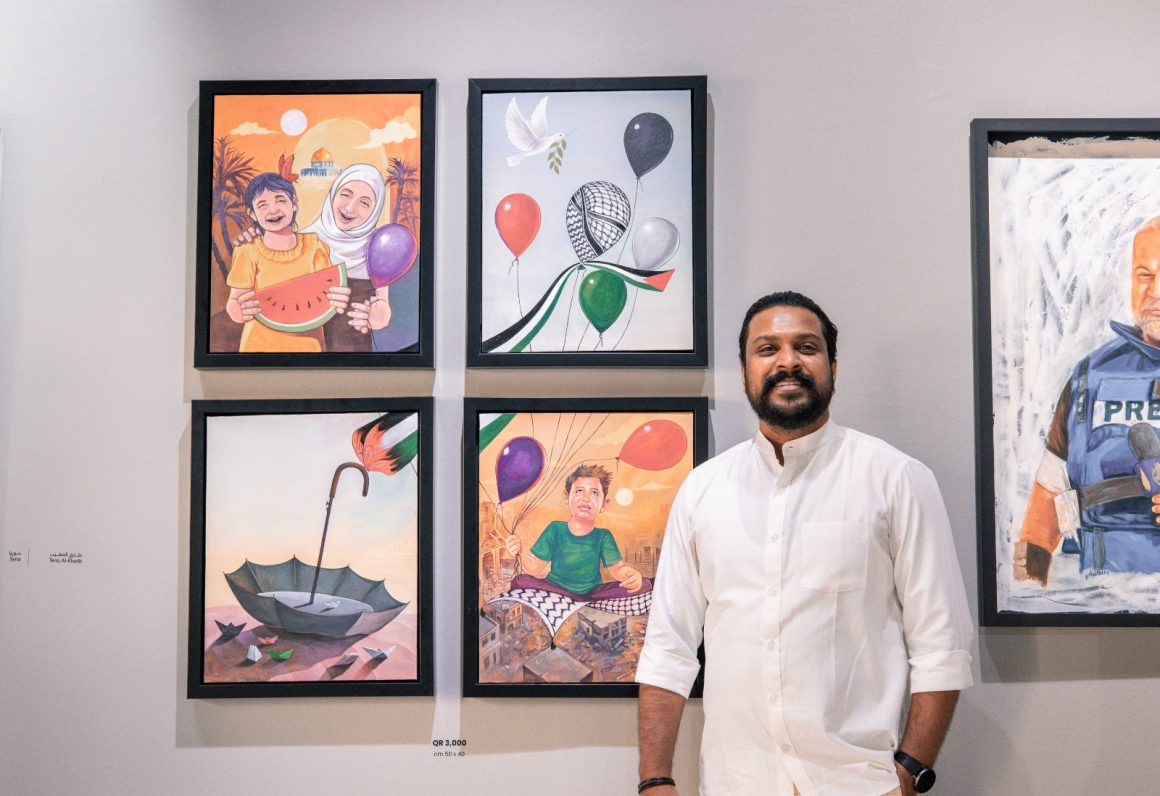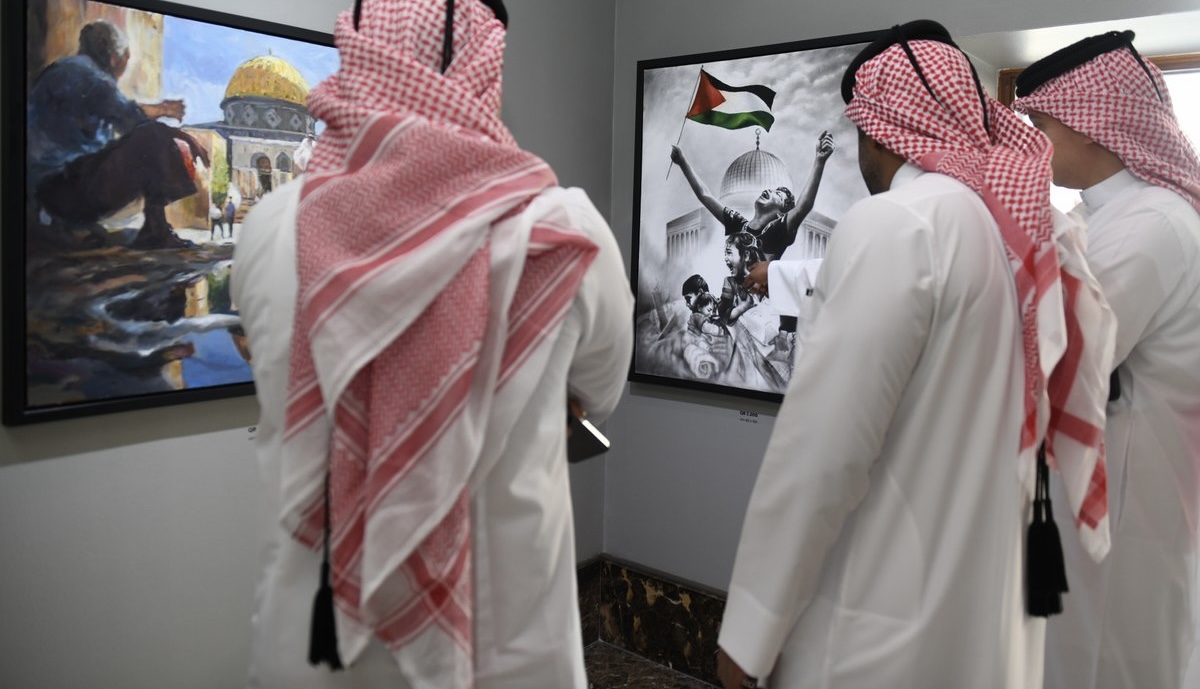Speaking to Doha News, Faisal Al Abdulla, Sheetal Dandekar and Rajeesh Ravi explained why it was important for them to participate in the ‘Gaza in Our Eyes’ exhibition.
On Tuesday, Souq Waqif’s Art Center unveiled their latest exhibition entitled ‘Gaza in Our Eye’.
The Art Center transformed into a beacon of Qatar’s solidarity with Palestine, showcasing the visual messages of hope and calls for peace from 32 local artists.
The participating artists reflected the diversity of Qatar’s community, with many hailing from Qatar, Oman, Sudan, Iraq, Morocco and India.
‘Gaza in Our Eyes’ comes at a time of no let up in Israel’s relentless onslaught of the Gaza Strip, dating back to October 7.
Since then, Euro-Med Monitor estimates that over 27,000 civilians have died as a result of Israeli shelling.
Rowdha Al Mansoori, the Art Center’s manager, said that the title of the exhibition “implies that all artists participating in the event are embodying the artistic paintings based on their own perspectives, how they see incidents in Gaza to further translate their feelings and depict them through colours on artistic paintings”.
Doha News caught up with participating artists Faisal Al Abdulla, Sheetal Dandekar and Rajeesh Ravi.
We discussed whether artists have a social responsibility to use their talents to draw attention to the plight of the Palestinians as the humanitarian crisis continues to worsen, as well as the messages they aim to convey through their artwork.
“I tried to convey Palestinian suffering, and show there is still hope”
Faisal Al Abdulla is a Qatari painter whose work has graced the walls of Qatar’s Katara Art Center .
He was also at the forefront of introducing Qatar’s visiting guests to the state’s local culture during his participation in the November 2022 ‘Doha Art’ exhibition at the Souq Waqif’s Art Center in the run up to the 2022 FIFA World Cup games.
On the Art Center’s latest exhibition, Al Abdulla said that it underscores the importance of expressing the sombre feelings of Qatar’s community during this time.
“Through ‘Gaza in Our Eyes,’ we are showing solidarity with our brethren in Gaza,” he said.
He added that through his paintings, he tried to convey the suffering of Palestinians, especially the innocent children, by depicting their fears and anxieties amid the destruction of their homeland and Israel’s constant bombardment.
However, “in the darkness of destruction, I believe there is still hope for peace,” he said.

Qatar has been at the forefront of mediation efforts pushing for an end to Israeli aggression against the Palestinians.
On Saturday, The New Arab reported that Israel’s divided war cabinet was discussing a Qatari proposal of a month-long truce, in exchange for the release of an unspecified number of Palestinian prisoners held in Israel. As part of this reported deal, between 40 to 50 hostages would also be released from Gaza by Hamas.
When asked what he chose to name his painting series for the exhibition, Al Abdulla said “I deliberately chose not to title my artwork.”
“Perhaps observers can give my paintings a fitting name for them based on how the imagery moves them.”
“Geography may divide us, but we are united in humanity”
Echoing Al Abdulla’s sentiment, Sheetal Dandekar decided to title her painting for the exhibition simply ‘Hope’.
Dandekar is an Indian artist from Mumbai, who joined Qatar’s vibrant art community in Doha nine years ago.
“I’m fascinated by the interplay between light and shadows – you see that in most of my work, including ‘Hope’,” she said.
Her painting for ‘Gaza in Our Eyes’ is divided into two components.
“You have the little Palestinian girl in the front, whose face is darkened by shadows – just as her country’s buildings and infrastructure have been darkened by the war,” Dandekar explained.

In the United Nations Office for the Coordination of Humanitarian Affairs latest impact report published on Saturday, it is estimated that at least 60% of Gaza’s housing units have either been completely destroyed or sustained damage since October 7.
UN OCHA further reported that 115 mosques and 3 churches in Gaza have been hit by Israel’s military offensive on the besieged Strip.
“But at the background of my painting, you see the bright yellow sky illuminating a shining mosque and birds flying freely amid the scene of rubble and sadness. This colour choice at the backdrop is to show that peace, positivity and hope are on the horizon,” Dandekar added.
She also said that artists have a history of influence on societies, and therefore, they hold a responsibility to speak up through their art.
“Geography may divide us, but we are all united in humanity. I felt it was important for me to not only show the impact the war is having on Palestinians, but also push for a message of unity and solidarity,” she concluded.
“I want my paintings to inspire all people to reflect”
Rajeesh Ravi, an Indian artist from Kerala who has been living in Qatar for 15 years, showcased a four-canvas painting series for the exhibition, each encapturing different themes while being interconnected by the Palestinian flag.
The first painting he worked on, featuring a Palestinian boy in flight on a flying kufiyyeh, was titled ‘War’.

“This canvas highlights the impact of war on children and, as you can see, the boy I drew is sad,” Ravi explained.
Beyond the scars of conflict, Palestine’s Health Ministry said intense Israeli shelling is inflicting psychological trauma on the besieged Strip’s women and children, Roya News reported on Saturday.
His first piece is juxtaposed by a still life canvas titled ‘Fire’.
“We see no children, or people in this painting, except their belongings that they left behind”. Here, he depicted an abandoned umbrella and DIY paper boats made with white, green, black and red paper.
“Buildings have been destroyed, but so many stories and dear memories of Palestinians have been destroyed, too. The fire of war is indiscriminate,” he said.
Meanwhile, his ‘Peace’ and ‘Divine’ paintings spotlight Palestinian resistance and resilience in the face of Israeli aggression.
“Abstractly, I’ve used Palestinian resistance symbols, such as the kufiyyeh and watermelon slices, to show the spirit of resistance we see in all Palestinians. Ultimately, I want my painting to inspire all people to reflect on this”.
For Ravi, if observers are able to connect with his abstract message through his painting series and feel the emotions he strived to convey, only then will he consider his participation in ‘Gaza in Our Eyes’ successful.







